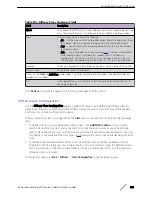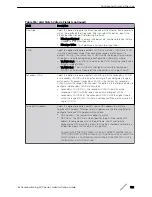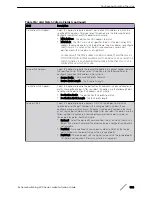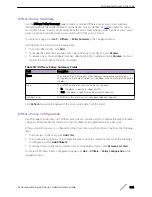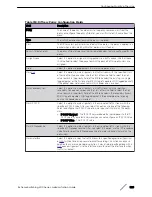
Table 305: Access Control List Statistics Fields (continued)
Field
Description
Match Conditions
The criteria used to determine whether a packet or frame matches the ACL rule.
Rule Attributes
Each action — beyond the basic Permit and Deny actions — to perform on the
traffic that matches the rule.
Hit Count
Indicates the number of packets that match the configured rule in an ACL. If a
rule is configured without rate limit, then the hit count is the number of matched
packets forwarded or discarded by the port. If a rule is configured with rate limit,
then if the sent traffic rate exceeds the configured rate, the hit count displays the
matched packet count equal to the sent rate, despite packets getting dropped
beyond the configured limit. If the sent traffic rate is less than the configured
rate, the hit count displays only the matched packet count.
Configuring Auto VoIP
Voice over Internet Protocol (VoIP) allows you to make telephone calls using a computer network over a
data network like the Internet. With the increased prominence of delay-sensitive applications (voice,
video, and other multimedia applications) deployed in networks today, proper
ensure high-quality application performance. The Auto VoIP feature is intended to provide an easy
classification mechanism for voice packets so that they can be prioritized above data packets in order to
provide better QoS.
The Auto-VoIP feature explicitly matches VoIP streams in Ethernet switches and provides them with a
better class of service than ordinary traffic. If you enable the Auto-VoIP feature on an interface, the
interface scans incoming traffic for the following call-control protocols:
•
Session Initiation Protocol (SIP)
•
H.323
•
Skinny Client Control Protocol (SCCP)
When a call-control protocol is detected the switch assigns the traffic in that session to the highest
queue, which is generally used for time-sensitive traffic.
Auto VoIP Global Configuration
Use the Auto VoIP Global Configuration page to configure the VLAN ID for the Auto VoIP VLAN or to
reset the current Auto VoIP VLAN ID to the default value. Voice over Internet Protocol (VoIP) enables
telephone calls over a data network. Because voice traffic is typically more time-sensitive than data
traffic, the Auto VoIP feature helps provide a classification mechanism for voice packets so that they can
be prioritized above data packets in order to provide better
With the Auto VoIP feature, voice prioritization is provided based on call-control protocols (SIP, SCCP, H.
323) and/or OUI bits. When the device identifies voice traffic, it is placed in the VLAN specified on this
page. The Auto VoIP feature does not rely on LLDP-MED support in connected devices.
To display this page, click
QoS
>
Auto VoIP
>
Global
in the navigation menu.
Configuring Quality of Service
ExtremeSwitching 200 Series: Administration Guide
312






















